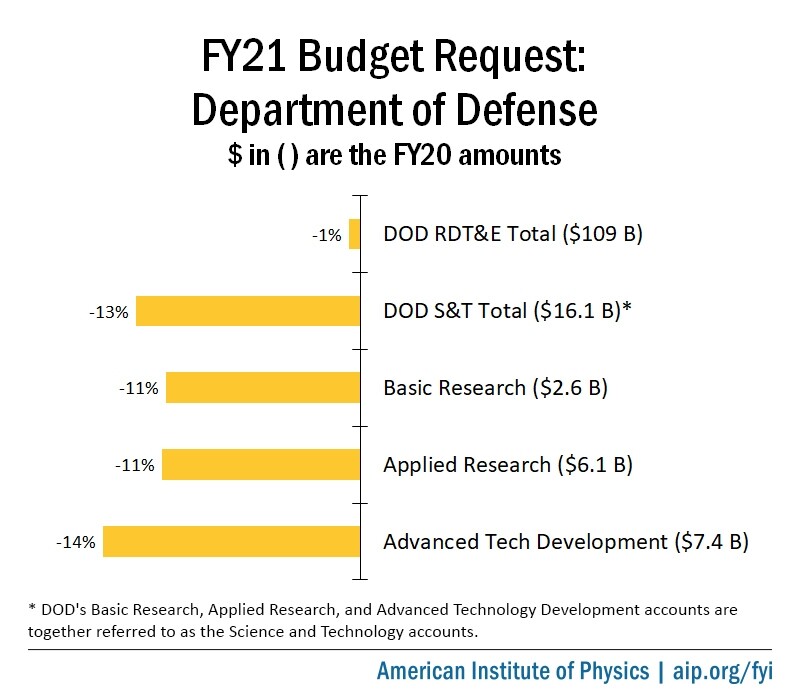
FY21 Budget Request: Department of Defense
The Trump administration is seeking about $108 billion for Department of Defense Research, Development, Test, and Evaluation activities in its fiscal year 2021 budget request

Echoing its previous proposals, DOD is seeking less than the enacted amounts for early-stage R&D, requesting a total of about $14 billion for its Basic Research, Applied Research, and Advanced Technology Development accounts. The administration’s emphasis on later-stage prototyping, testing, and evaluation activities is consistent with DOD’s recent prioritization of advancing cutting-edge technologies into use.
In recent written testimony
Summary figures from the request and previous appropriations for R&D programs across military service branches are available in FYI’s Federal Science Budget Tracker
Basic research and STEM education
Basic research. Overall funding for DOD’s Basic Research accounts would drop 11% to $2.32 billion under the request, with cuts spread across military service branches. Within the Office of the Secretary of Defense, DOD proposes cutting the Basic Research Initiatives account in half to $36 million. Of that amount, $32 million would go to the Vannevar Bush Faculty Fellowship program and the pilot Laboratory University Collaboration Initiative
National Defense Education Program. DOD proposes to roll back funding for its National Defense Education Program from $144 million to $100 million. Congress has driven recent increases to the program’s budget, which have gone toward initiatives such as funding
Minority Serving Institutions. DOD is requesting $31 million for its program to support Historically Black Colleges and Universities and other Minority Serving Institutions, about the same as it requested last year. However, Congress has recently exceeded the administration’s requests for the program, ramping up funding to its current level of $53 million. DOD indicates it plans to use the extra funding this year in part to establish three new research centers dedicated respectively to aerospace research and education, materials science, and biotechnology. The request notes the department is planning additional such centers dedicated to artificial intelligence and machine learning, biotechnology, quantum science, and fully networked command, control, and communications.
Research security
Within the Office of the Secretary of Defense, DOD proposes increasing funding from $21 million to $30 million for a recently established program called “Maintaining Technology Advantage,” comprising several projects focused on protecting U.S. science and technology from exploitation by foreign governments.
Technology Area Protection Plans. DOD requests $9 million to develop security policies tailored to specific technology areas with the aim of ensuring “accountability for mitigating adversary exploitation.” Among the activities associated with this effort are the development of “threshold determinations” for what constitutes Controlled Technical Information
Technology Innovation Base. About $7 million is requested for a new project called the Technology Innovation Base that addresses a separate congressional mandate

Under Secretary of Defense for Research and Engineering Mike Griffin speaks at a National Engineers Week event in February 2020.
(Image credit – Marine Corps Sgt. Ryan G. Coleman / DOD)
Protecting extramural research. Griffin told HASC that DOD is participating in interagency efforts to develop policies for protecting “open research” at universities and other institutions. He recounted, “In March 2019, we issued instructions
Sustaining scientific exchange. Griffin stressed that protection policies must be appropriately tailored, writing that an “uncoordinated, broad-brush approach to technology protection can result in damaging consequences that limit our ability to engage with and benefit from leading-edge research.” He observed, “Today’s U.S. universities welcome a high percentage of international students, scientists, professors, and industry collaborators, even as our adversaries recruit U.S. and foreign personnel for the benefit of their global dominance. Our strategic imperative is to continue to draw the best high-skilled talent to the U.S. research enterprise. … We want these talented individuals to come here, to stay here, and to choose to work with us no matter where they were born.” These remarks contrast with Griffin’s rhetoric two years ago
Selected technology priorities
Space-based missile detection. DOD seeks to increase funding for the Next-Generation Overhead Persistent Infrared (Next-Gen OPIR) satellite constellation from $1.47 billion to $2.32 billion. The system is intended to succeed the current Space-Based Infrared System as a ballistic missile early warning system and comprises a significant fraction of the Space Force RDT&E budget. The project is employing special rapid acquisition authorities and the Department of the Air Force, which oversees the Space Force, regards
Hypersonics. According to Griffin’s HASC testimony, DOD is seeking to increase its total spending on hypersonics from $2.7 billion to $3.2 billion. As an example of priority work in the area, he cited plans to accelerate a hypersonic weapon the Army is developing and for which DOD is seeking to double funding to $801 million. Griffin further stated, “We are also moving towards flight testing of many of our hypersonic weapon system prototypes in 2020. We intend to conduct approximately 40 flight tests over the next four years, with the goal of delivering new capabilities to our warfighters years earlier than previously planned.” Last month, DOD announced

Directed energy weapons. Griffin reported that the Navy is planning to test new laser and high-power microwave weapon prototypes
Quantum information science. Describing DOD’s priorities in QIS, Griffin stated, “We will continue to emphasize atomic clocks and sensors — these quantum technologies provide the most concrete opportunities for continued warfighting advantage. Longer-term, advances in quantum computing and quantum networking may have an impact on our joint warfighting concepts. Still we caution that hyperbole surrounding these topics may be getting ahead of their military and economic utility.”
Microelectronics. Griffin told HASC that DOD’s efforts to increase the security of the microelectronics components it acquires are moving beyond a “trusted foundry” production model that is focused on building secure technological “perimeters.” He stated the department is instead taking cues from the field of cybersecurity and adopting a “zero-trust, risk-management-based approach to security along the entire life-cycle of microelectronics (to include design, manufacturing, assembly, test, and packaging), informed by data, not perimeters.” He indicated those efforts complement the Defense Advanced Research Projects Agency’s ongoing Electronics Resurgence Initiative
Advanced telecommunications. DOD proposes to increase funding for its recently established Next Generation Information Communications Technology Program from $200 million to $449 million and to create an associated $35 million early-stage R&D program. Together these programs comprise a new initiative known as “5G to Next G.”
Chemical and biological threats
Cooperative Threat Reduction program. DOD proposes
Chemical and Biological Defense. DOD is proposing


